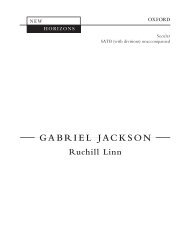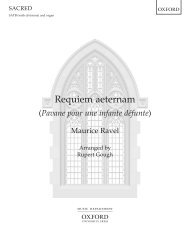New Oxford Organ Method
A single piece of repertoire is the primary focus for each chapter, with preparatory exercises providing the necessary technical work building towards the piece. Each lesson covers four main topics, which are systematically developed: practice methods, registration, fingering and pedalling, and historically-informed interpretation. The method is for keyboard players of any age who are establishing first steps at the organ with or without a teacher. It will also serve more experienced organists who want to improve their technique.
A single piece of repertoire is the primary focus for each chapter, with preparatory exercises providing the necessary technical work building towards the piece. Each lesson covers four main topics, which are systematically developed: practice methods, registration, fingering and pedalling, and historically-informed interpretation. The method is for keyboard players of any age who are establishing first steps at the organ with or without a teacher. It will also serve more experienced organists who want to improve their technique.
- No tags were found...
You also want an ePaper? Increase the reach of your titles
YUMPU automatically turns print PDFs into web optimized ePapers that Google loves.
Chapter 16<br />
215<br />
Similarly, repeated notes on the pedals may need more separation than they do on the manuals because of their<br />
low pitch. Look at this exercise from Lobe den Herren, and notice that the first three notes have tenuto marks:<br />
?# 3<br />
2<br />
Play them like this:<br />
?# 3<br />
2<br />
-˙ -˙ ˙-<br />
˙ ˙ ˙<br />
m ¡ m<br />
m - œ Œ œ - Œ œ - Œ ˙ ˙ ˙<br />
(bb. 14–15)<br />
(bb. 14–15)<br />
for online perusal only<br />
Pivoting in a rest<br />
In Chapter 8, you learned to pivot against a sustained note—a sustained left-foot note to pivot to the right,<br />
and a sustained right-foot note to pivot to the left. But sometimes there is no suitable note available to<br />
support your pivoting. For example, in the exercise below you need to pivot to the right after the fourth<br />
note, ready for the next entry. The fourth note is unsuitable for support because you are playing it with your<br />
right foot. Instead, wait until the rest, hook your right toe against the side of Eb, and pull your lower body<br />
comfortably into home position:<br />
Place feet on<br />
3<br />
m<br />
home position<br />
?#<br />
m ¡ m<br />
2<br />
∑<br />
˙ # ˙ ˙ w<br />
m¡ m ¡<br />
m - ˙ - ˙ - ˙ ˙ ˙ ˙<br />
(bb. 11–15)<br />
Home position is, of course, a navigation point, but you can hook your toe against any navigation point<br />
to pull your lower body into a new position, enabling you to pivot in a rest. From now on, when you are<br />
finding the first pedal notes of a piece, use navigation points to guide your feet to their initial notes.<br />
Combining pedal techniques in quick succession<br />
Play the following exercise, which is the complete pedal part without the dynamic changes. It combines<br />
legato techniques in the pedal, some in quick succession. Apply legato touch except for notes which repeat<br />
or have a tenuto mark. The annotations will help you find the notes, suggest techniques, and prompt you to<br />
pivot. First play with your hands on the key cheeks, and then repeat while adopting the ‘hands up’ position:


















